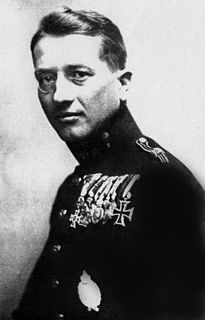
Godwin von Brumowski was the most successful fighter ace of the Austro-Hungarian Air Force during World War I. He was officially credited with 35 air victories, with 8 others unconfirmed because they fell behind Allied lines. Just before the war ended, von Brumowski rose to command of all his country's fighter aviation fighting Italy on the Isonzo front.
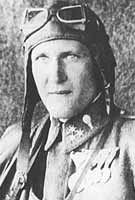
Julius Kowalczik was a Austro-Hungarian World War I flying ace credited with five aerial victories. Though he joined military service as the war began in 1914, he did not transfer to the Austro-Hungarian Aviation Troops until late 1915. Qualified as a fighter pilot in February 1916, he went into action in northern Italy the following month. He would score five aerial victories between 14 October 1916 and 29 June 1917. After surviving being shot down by Italian aces Antonio Amantea and Antonio Riva on 24 August 1917, Kowalczik was reassigned to instructor duty in January 1918. He survived the war, having won two Silver and two Gold Medals for Bravery.
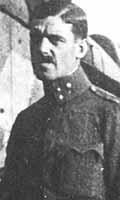
Oberleutnant Béla Macourek was a Austro-Hungarian World War I flying ace credited with five aerial victories. He entered the First World War as a mounted artillery officer. Two years campaigning brought him a Bronze Military Merit Medal. In mid-1916, he volunteered as an aerial observer. Over the next two years, he would progress to pilot, deputy commander, then commander while destroying five enemy airplanes. He was awarded the Silver Military Merit Medal and the Military Merit Cross.
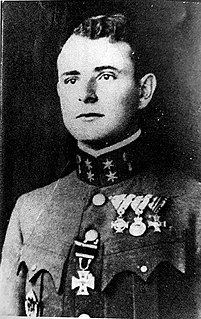
OberleutnantKarl Patzelt (1893-1918) was an Austro-Hungarian World War I flying ace credited with five aerial victories. Entering World War I as an officer in an infantry regiment, he distinguished himself during the first two years of the war. Decorated twice for valor, he was also honored by a rare early promotion in rank. A serious wound inflicted on 16 June 1916 hospitalized him. While recuperating, he transferred to aviation service. Trained and posted as a technical officer for Flik 29J in Romania, he volunteered to fly as an observer with Andreas Dombrowski. On their missions, Patzelt would benefit from Dombrowski's tuition as a pilot, while downing two enemy aircraft with the observer's gun. In October, Patzelt was transferred to the Italian Front to observe at the Battle of Caporetto. By mid-November 1917, he was flying with a fighter squadron, Flik 42J. He would score three more victories before being killed in action on 4 May 1918.
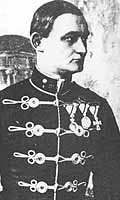
OberleutnantRudolf Szepessy-Sokoll Freiherr von Negyes et Reno was a Hungarian World War I flying ace credited with five aerial victories. He began his military career as a cavalryman as the war began in 1914. After winning the Silver Medal for Bravery and being promoted into the officers' ranks, he transferred to the Austro-Hungarian Aviation Troops in mid-1915 as an aerial observer. On 14 February 1916, while participating in a historic strategic bombing raid on Milan, he scored his first aerial victory. After shooting down another airplane and an observation balloon, Szepessy-Sokoll was transferred to a fighter unit after pilot training. After shooting down a pair of Macchi L.3s on 5 November 1917, he was killed in action the next day.
Franz Wognar (1890-1943) was an Austrian-Hungarian World War I flying ace credited with five aerial victories. Wognar joined the Austro-Hungarian Armed Forces in 1913 as a trained mechanic. As the war broke out in 1914, he transferred to the Austro-Hungarian Aviation Troops. After pilot training, he was posted to fly two-seater reconnaissance aircraft over the early Battles of the Isonzo in northern Italy. Wognar flew reconnaissance, aerial photo, and artillery direction missions throughout 1916. Between 26 January and 16 September 1917, Wognar would score five victories. His fifth victory, over an Italian observation balloon, was extraordinary because very few pilots succeeded in balloon busting with a two-seater plane. Wognar was reassigned to test pilot duty. He ended the war with one Gold and four Silver awards of the Medal for Bravery.

FeldwebelAndreas Dombrowski was an Austro-Hungarian World War I flying ace credited with six aerial victories scored on three different fronts. He was conscripted into the Austro-Hungarian military in 1915. Dombrowski underwent pilot's training, gaining his license in June 1916. Posted to the Russian Front during the Brusilov Offensive to fly reconnaissance, he was credited with his first victory on 17 August 1916. In September, 1916 he was transferred to the Romanian Front. Still flying a reconnaissance aircraft, he fought four more successful engagements during 1917, becoming an ace. Transferred to the Italian Front in April 1918, he flew an Albatros D.III for his former observer, Karl Patzelt. On 4 May 1918, Dombrowski scored his sixth and final victory, then took a bullet to the face and crashlanded. Once healed, he went to a photographic reconnaissance unit for the rest of the war.

Johann Frint was an Austro-Hungarian flying ace during World War I and professional soldier credited with six aerial victories while flying as an aerial observer. Crippled as an infantry officer in November 1914, Frint volunteered for the Austro-Hungarian Aviation Troops. He scored his victories on the Italian Front from the rear seat of two-seater reconnaissance aircraft with a variety of pilots, including a triple victory while being flown by his commanding officer, Heinrich Kostrba. Rewarded with the Order of the Iron Crown and Military Merit Medal, Frint became a mediocre pilot. He was entrusted with successive commands of a number of squadrons before dying in an airplane crash in 1918.
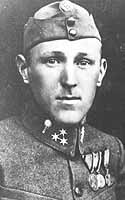
FeldwebelAlexander Kasza was an Austro-Hungarian World War I flying ace credited with six aerial victories.

Roman Oto Kažimir Schmidt or Roman Šmidt (1893-1959) was a World War I flying ace of the Austro-Hungarian Aviation Troops, credited with six aerial victories.

OberleutnantRudolf Weber was an Austro-Hungarian World War I flying ace credited with six aerial victories. Weber was an experienced infantry officer when World War I began in 1914, and he went into action on the Russian Front. He transferred to aerial service in late 1915. During his 1916 service as an observer, he scored his first victory and suffered a disfiguring wound to his face. Once healed, he trained as a pilot and returned to action, but on the Italian Front. Between 11 August and 26 October 1917, he scored five more victories. In January 1918, he was posted to command Flik 102G, a night bombing squadron. In October 1918, as the Austro-Hungarian Empire dissolved in defeat, Weber led an exodus home from his unit. Along the way, a trigger-happy militiaman shot Weber to death.

OberleutnantLudwig Hautzmayer (1893-1936) was an Austro-Hungarian World War I flying ace credited with seven aerial victories. He was a prewar reserve infantry officer; when war broke out, he fought until suffering a severe leg wound on 8 September 1914. When recovered, he transferred to the Austro-Hungarian Aviation Troops as an aerial observer in March, 1915. After 40 combat missions on the Eastern Front, he underwent fighter pilot training. Once qualified, he was posted to the Isonzo Front, where he became an ace. Appointed commander of his own fighter squadron, Flik 61J, he was one of the few reserve officers so entrusted as a leader. After scoring two more victories, he ended the war with multiple decorations, up to the Order of Leopold. Postwar, he flew as an airline pilot for Malert until killed in a crash at Croydon, England on 6 December 1936.

OberleutnantOtto Jäger was an Austro-Hungarian World War I flying ace credited with seven aerial victories. He entered the war in 1914 as an infantry officer. By mid-1915, he had suffered three serious wounds fighting on the Russian Front, winning the Military Merit Medal, Silver Medal for Bravery, and the German War Service Medal. Invalided from front line service to training duties, Jäger trained as an aerial observer. Posted back to the Russian Front to fly with Fliegerkompanie 10 in early 1916, Jäger scored his fifth victory on 2 August 1916. He was awarded the Silver Military Merit Medal, the Military Merit Cross, and the German Iron Cross Second Class.
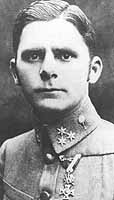
Hauptmann Josef von Maier was an Austro-Hungarian World War I flying ace credited with seven aerial victories. József Modory

OberleutnantAlexander Tahy was a Hungarian World War I flying ace credited with eight aerial victories while serving with the Austro-Hungarian Aviation Troops. He began the war as an artilleryman, winning the Silver Medal for Bravery in May 1915. In early 1916, he transferred to aviation duty as an aerial observer. Between 3 December 1916 and 26 June 1917, he was credited with five aerial victories for Fliegerkompanie 19, earning another three decorations. Having taught himself to fly, he transferred to a fighter unit, Fliegerkompanie 51J for his last three victories. On 7 March 1918, Tahy died in a flying accident. His greatest honor came after his death, when he was awarded the Knight's Cross of the Order of Leopold with War Decorations and Swords.
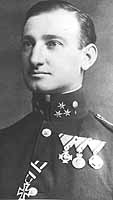
Hauptmann Otto Jindra was an Austro-Hungarian flying ace during World War I, credited with nine aerial victories while flying as an aerial observer. His abilities as both leader and administrator led to his accelerated promotion and appointments to command of aviation units despite his lack of pilot's credentials. After World War I and Austria-Hungary both ended, Jindra became a major mover in founding a Czechoslovakian air arm, which he eventually rose to command.

Kurt Gruber was an Austro-Hungarian flying ace during the First World War who held the rank of Offiziersstellvertreter. He was credited with eleven aerial victories, 5 shared with other pilots.
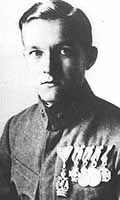
Oberleutnant Franz Rudorfer was an Austro-Hungarian World War I flying ace credited with eleven confirmed and two unconfirmed aerial victories.

















